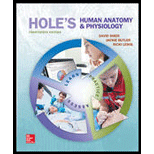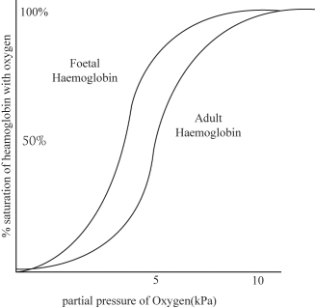
Hole's Human Anatomy & Physiology
14th Edition
ISBN: 9780078024290
Author: David N. Shier Dr., Jackie L. Butler, Ricki Lewis Dr.
Publisher: McGraw-Hill Education
expand_more
expand_more
format_list_bulleted
Concept explainers
Question
Chapter 23, Problem 21CA
Summary Introduction
To compare:
The properties of fetal hemoglobin and adult hemoglobin.
Introduction:
Hemoglobin is a metalloprotein (iron + protein) found in the RBCs (red blood cells), which provide red color to the RBCs. Hemoglobin helps in the oxygen transportation of the body. One molecule of hemoglobin can carry four molecules of oxygen.
Pictorial representation:
Fig. 1:Dissociation curve of fetal and adult hemoglobin.

Fig. 1:Dissociation curve of fetal and adult hemoglobin.
Expert Solution & Answer
Trending nowThis is a popular solution!

Students have asked these similar questions
How do the muscles on the foot work to balance on an ice skate, specifically the triangle of balance and how does it change when balancing on an ice skate? (Refer to anatomy, be specific)
Which of the following is NOT an example of passive immunization?
A.
Administration of tetanus toxoid
B.
Administration of hepatitis B immunoglobulin
C.
Administration of rabies immunoglobulin
D.
Transfer of antibodies via plasma therapy
Transcription and Translation
1. What is the main function of transcription and translation? (2
marks)
2. How is transcription different in eukaryotic and prokaryotic
cells? (2 marks)
3. Explain the difference between pre-mRNA and post-transcript
mRNA. (2 marks)
4. What is the function of the following: (4 marks)
i. the cap
ii. spliceosome
iii. Poly A tail
iv. termination sequence
5. What are advantages to the wobble feature of the genetic
code? (2 marks)
6. Explain the difference between the: (3 marks)
i. A site & P site
ii. codon & anticodon
iii. gene expression and gene regulation
7. Explain how the stop codon allows for termination. (1 mark)
8. In your own words, summarize the process of translation. (2
marks)
Chapter 23 Solutions
Hole's Human Anatomy & Physiology
Ch. 23 - Prob. 1PCh. 23 - What factors aid the movements of the secondary...Ch. 23 - Prob. 3PCh. 23 - Prob. 4PCh. 23 - Prob. 5PCh. 23 - Prob. 6PCh. 23 - Prob. 7PCh. 23 - Prob. 8PCh. 23 - Prob. 9PCh. 23 - Prob. 10P
Ch. 23 - Prob. 11PCh. 23 - Prob. 12PCh. 23 - Prob. 13PCh. 23 - Prob. 14PCh. 23 - Prob. 15PCh. 23 - Prob. 16PCh. 23 - Prob. 17PCh. 23 - Prob. 18PCh. 23 - Prob. 19PCh. 23 - Prob. 20PCh. 23 - Prob. 21PCh. 23 - Prob. 22PCh. 23 - Prob. 23PCh. 23 - Prob. 24PCh. 23 - Prob. 25PCh. 23 - Prob. 26PCh. 23 - Prob. 27PCh. 23 - Prob. 28PCh. 23 - Prob. 29PCh. 23 - Prob. 30PCh. 23 - What does a newborn use for energy during its...Ch. 23 - Prob. 32PCh. 23 - Prob. 33PCh. 23 - Prob. 34PCh. 23 - Prob. 35PCh. 23 - Prob. 36PCh. 23 - Prob. 37PCh. 23 - Prob. 38PCh. 23 - Prob. 39PCh. 23 - Prob. 40PCh. 23 - Prob. 41PCh. 23 - How is aging a passive process?Ch. 23 - Prob. 43PCh. 23 - Prob. 44PCh. 23 - Prob. 1CACh. 23 - Prob. 2CACh. 23 - Prob. 3CACh. 23 - Describe the process of cleavage. (pp. 870-871)Ch. 23 - Prob. 5CACh. 23 - Prob. 6CACh. 23 - Prob. 7CACh. 23 - Prob. 8CACh. 23 - Prob. 9CACh. 23 -
10 Explain the function of the amniotic fluid....Ch. 23 - Prob. 11CACh. 23 - Prob. 12CACh. 23 - Prob. 13CACh. 23 - Prob. 14CACh. 23 - Prob. 15CACh. 23 - Prob. 16CACh. 23 - Prob. 17CACh. 23 - Prob. 18CACh. 23 - Prob. 19CACh. 23 - Explain how the fetal cardiovascular system is...Ch. 23 - Prob. 21CACh. 23 - Prob. 22CACh. 23 - Prob. 23CACh. 23 - Prob. 24CACh. 23 - Prob. 25CACh. 23 - Prob. 26CACh. 23 - Explain positive feedback and the role of hormones...Ch. 23 - Prob. 28CACh. 23 - Prob. 29CACh. 23 - Prob. 30CACh. 23 - Prob. 31CACh. 23 - Prob. 32CACh. 23 - Prob. 33CACh. 23 - Prob. 34CACh. 23 - Prob. 35CACh. 23 - Prob. 36CACh. 23 - Prob. 37CACh. 23 - Prob. 38CACh. 23 - Prob. 39CACh. 23 - Prob. 40CACh. 23 - Prob. 41CACh. 23 - Prob. 42CACh. 23 - Prob. 1IACh. 23 - Prob. 2IACh. 23 - Prob. 3IACh. 23 - Prob. 4IACh. 23 -
5. Why do toxins cause more severe medical...Ch. 23 - What technology would enable a fetus born in the...
Knowledge Booster
Learn more about
Need a deep-dive on the concept behind this application? Look no further. Learn more about this topic, biology and related others by exploring similar questions and additional content below.Similar questions
- In this activity you will research performance enhancers that affect the endocrine system or nervous system. You will submit a 1 page paper on one performance enhancer of your choice. Be sure to include: the specific reason for use the alleged results on improving performance how it works how it affect homeostasis and improves performance any side-effects of this substancearrow_forwardNeurons and Reflexes 1. Describe the function of the: a) dendrite b) axon c) cell body d) myelin sheath e) nodes of Ranvier f) Schwann cells g) motor neuron, interneuron and sensory neuron 2. List some simple reflexes. Explain why babies are born with simple reflexes. What are they and why are they necessary. 3. Explain why you only feel pain after a few seconds when you touch something very hot but you have already pulled your hand away. 4. What part of the brain receives sensory information? What part of the brain directs you to move your hand away? 5. In your own words describe how the axon fires.arrow_forwardMutations Here is your template DNA strand: CTT TTA TAG TAG ATA CCA CAA AGG 1. Write out the complementary mRNA that matches the DNA above. 2. Write the anticodons and the amino acid sequence. 3. Change the nucleotide in position #15 to C. 4. What type of mutation is this? 5. Repeat steps 1 & 2. 6. How has this change affected the amino acid sequence? 7. Now remove nucleotides 13 through 15. 8. Repeat steps 1 & 2. 9. What type of mutation is this? 0. Do all mutations result in a change in the amino acid sequence? 1. Are all mutations considered bad? 2. The above sequence codes for a genetic disorder called cystic fibrosis (CF). 3. When A is changed to G in position #15, the person does not have CF. When T is changed to C in position #14, the person has the disorder. How could this have originated?arrow_forward
- hoose a scientist(s) and research their contribution to our derstanding of DNA structure or replication. Write a one page port and include: their research where they studied and the time period in which they worked their experiments and results the contribution to our understanding of DNA cientists Watson & Crickarrow_forwardhoose a scientist(s) and research their contribution to our derstanding of DNA structure or replication. Write a one page port and include: their research where they studied and the time period in which they worked their experiments and results the contribution to our understanding of DNA cientists Watson & Crickarrow_forward7. Aerobic respiration of a protein that breaks down into 12 molecules of malic acid. Assume there is no other carbon source and no acetyl-CoA. NADH FADH2 OP ATP SLP ATP Total ATP Show your work using dimensional analysis here: 3arrow_forward
- For each of the following problems calculate the following: (Week 6-3 Video with 6-1 and 6-2) Consult the total catabolic pathways on the last page as a reference for the following questions. A. How much NADH and FADH2 is produced and fed into the electron transport chain (If any)? B. How much ATP is made from oxidative phosphorylation (OP), if any? Feed the NADH and FADH2 into the electron transport chain: 3ATP/NADH, 2ATP/FADH2 C. How much ATP is made by substrate level phosphorylation (SLP)? D. How much total ATP is made? Add the SLP and OP together. 1. Aerobic respiration using 0.5 mole of glucose? NADH FADH2 OP ATP SLP ATP Total ATP Show your work using dimensional analysis here:arrow_forwardAerobic respiration of one lipid molecule. The lipid is composed of one glycerol molecule connected to two fatty acid tails. One fatty acid is 12 carbons long and the other fatty acid is 18 carbons long in the figure below. Use the information below to determine how much ATP will be produced from the glycerol part of the lipid. Then, in part B, determine how much ATP is produced from the 2 fatty acids of the lipid. Finally put the NADH and ATP yields together from the glycerol and fatty acids (part A and B) to determine your total number of ATP produced per lipid. Assume no other carbon source is available. 18 carbons fatty acids 12 carbons glycerol . Glycerol is broken down to glyceraldehyde 3-phosphate, a glycolysis intermediate via the following pathway shown in the figure below. Notice this process costs one ATP but generates one FADH2. Continue generating ATP with glyceraldehyde-3-phosphate using the standard pathway and aerobic respiration. glycerol glycerol-3- phosphate…arrow_forwardDon't copy the other answerarrow_forward
- 4. Aerobic respiration of 5 mM acetate solution. Assume no other carbon source and that acetate is equivalent to acetyl-CoA. NADH FADH2 OP ATP SLP ATP Total ATP Show your work using dimensional analysis here: 5. Aerobic respiration of 2 mM alpha-ketoglutaric acid solution. Assume no other carbon source. NADH FADH2 OP ATP Show your work using dimensional analysis here: SLP ATP Total ATParrow_forwardBiology You’re going to analyze 5 ul of your PCR product(out of 50 ul) on the gel. How much of 6X DNAloading buffer (dye) are you going to mix with yourPCR product to make final 1X concentration ofloading buffer in the PCR product-loading buffermixture?arrow_forwardWrite the assignment on the title "GYMNOSPERMS" focus on the explanation of its important families, characters and reproduction.arrow_forward
arrow_back_ios
SEE MORE QUESTIONS
arrow_forward_ios
Recommended textbooks for you
 Human Anatomy & Physiology (11th Edition)BiologyISBN:9780134580999Author:Elaine N. Marieb, Katja N. HoehnPublisher:PEARSON
Human Anatomy & Physiology (11th Edition)BiologyISBN:9780134580999Author:Elaine N. Marieb, Katja N. HoehnPublisher:PEARSON Biology 2eBiologyISBN:9781947172517Author:Matthew Douglas, Jung Choi, Mary Ann ClarkPublisher:OpenStax
Biology 2eBiologyISBN:9781947172517Author:Matthew Douglas, Jung Choi, Mary Ann ClarkPublisher:OpenStax Anatomy & PhysiologyBiologyISBN:9781259398629Author:McKinley, Michael P., O'loughlin, Valerie Dean, Bidle, Theresa StouterPublisher:Mcgraw Hill Education,
Anatomy & PhysiologyBiologyISBN:9781259398629Author:McKinley, Michael P., O'loughlin, Valerie Dean, Bidle, Theresa StouterPublisher:Mcgraw Hill Education, Molecular Biology of the Cell (Sixth Edition)BiologyISBN:9780815344322Author:Bruce Alberts, Alexander D. Johnson, Julian Lewis, David Morgan, Martin Raff, Keith Roberts, Peter WalterPublisher:W. W. Norton & Company
Molecular Biology of the Cell (Sixth Edition)BiologyISBN:9780815344322Author:Bruce Alberts, Alexander D. Johnson, Julian Lewis, David Morgan, Martin Raff, Keith Roberts, Peter WalterPublisher:W. W. Norton & Company Laboratory Manual For Human Anatomy & PhysiologyBiologyISBN:9781260159363Author:Martin, Terry R., Prentice-craver, CynthiaPublisher:McGraw-Hill Publishing Co.
Laboratory Manual For Human Anatomy & PhysiologyBiologyISBN:9781260159363Author:Martin, Terry R., Prentice-craver, CynthiaPublisher:McGraw-Hill Publishing Co. Inquiry Into Life (16th Edition)BiologyISBN:9781260231700Author:Sylvia S. Mader, Michael WindelspechtPublisher:McGraw Hill Education
Inquiry Into Life (16th Edition)BiologyISBN:9781260231700Author:Sylvia S. Mader, Michael WindelspechtPublisher:McGraw Hill Education

Human Anatomy & Physiology (11th Edition)
Biology
ISBN:9780134580999
Author:Elaine N. Marieb, Katja N. Hoehn
Publisher:PEARSON

Biology 2e
Biology
ISBN:9781947172517
Author:Matthew Douglas, Jung Choi, Mary Ann Clark
Publisher:OpenStax

Anatomy & Physiology
Biology
ISBN:9781259398629
Author:McKinley, Michael P., O'loughlin, Valerie Dean, Bidle, Theresa Stouter
Publisher:Mcgraw Hill Education,

Molecular Biology of the Cell (Sixth Edition)
Biology
ISBN:9780815344322
Author:Bruce Alberts, Alexander D. Johnson, Julian Lewis, David Morgan, Martin Raff, Keith Roberts, Peter Walter
Publisher:W. W. Norton & Company

Laboratory Manual For Human Anatomy & Physiology
Biology
ISBN:9781260159363
Author:Martin, Terry R., Prentice-craver, Cynthia
Publisher:McGraw-Hill Publishing Co.

Inquiry Into Life (16th Edition)
Biology
ISBN:9781260231700
Author:Sylvia S. Mader, Michael Windelspecht
Publisher:McGraw Hill Education
Macromolecules | Classes and Functions; Author: 2 Minute Classroom;https://www.youtube.com/watch?v=V5hhrDFo8Vk;License: Standard youtube license